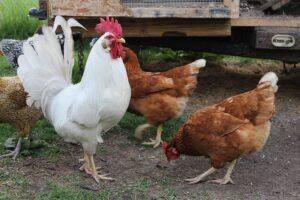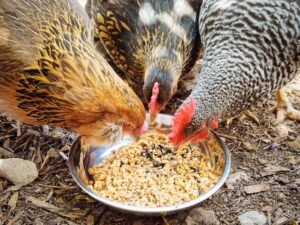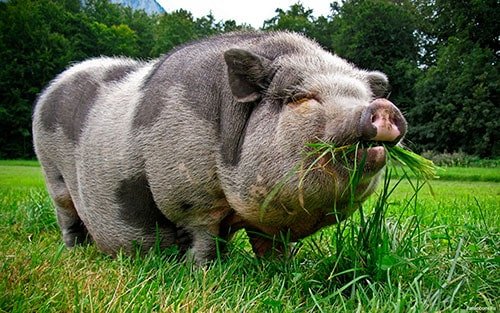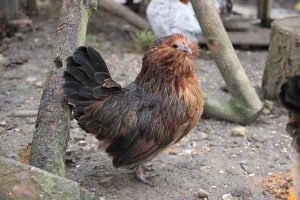Minorca Chicken – Characteristics, Origin, Breed Info and Lifespan
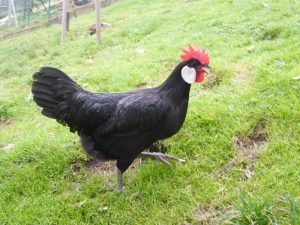
Minorca chicken is another breed of chicken with some fascinating characteristics that will interest you.
The Minorca chickens are excellent egg layers and they are pretty easy to care for.
As a result, they are one of America’s favorite chicken breeds since the late 1880s.
In this article, you will learn more about this Minorca chicken breed so that you will find reasons to get one.
Also, this will guide you to know whether Minorca chickens are the best breed for your farm or not.
So, if you are ready to learn more, keep scrolling…
What is Minorca Chicken?
The name of this chicken breed is very unique and special.
Minorca Chicken is a beautiful bird to look upon.
It has huge earlobes, large combs, and wattles.
It’s chiefly a dual-purpose breed that can be used for both meat and eggs.
But its egg-laying capacity has earned the bird great recognition.
Minorcas lay the most amazing and largest white eggs among the Mediterranean poultry breeds.
It is also known as an exhibition bird used for shows.

What is the Origin and history of Minorca Chicken?
The origin of Minorca Chicken can be traced back to the Mediterranean island of Menorca in Spain.
This breed was named after the island of Minorca, although it is also known as Red-Faced Black Chicken or Red-Faced Black Spanish.
Minorca Chicken is well known as an exhibition bird in many parts of the world.
Although on the island of Menorca it has become a species at risk of extinction.
Currently, the International type of Minorca Chicken that is present was created by the British from native Menorcan birds.
This took place between the year 1708 –1783 when the British occupied the island.
About 100 years later, the Minorca Chicken breed became common in Devon and Cornwall in the southeast of England.
There the Minorca Chicken was greatly considered an egg-laying bird.
During the 1870s our popular Minorca entered Germany and was added to the Standard of Perfection of the American Poultry Association in 1888.
Several attempts have been made to modify the physical characteristics of this unique bird.
These attempts targeted the size of their combs and earlobes, the position of the neck, and body size in general.
However, none of these attempts has been able to add any good effect on its egg-laying ability.
In Catalan, its other name is Gallina de Menorca, but in Spanish, it is either called Menorquina or Minorka.
If you ever have a Minorca Chicken do well to take good care of it, don’t just eat the eggs but try and reproduce its kind.
This way you can prevent it from going into extinction.
What are the Characteristics of Minorca Chickens?
Below are the features that distinguish this pretty bird from other breeds of chicken;
1. They have very large earlobes:
This is a betraying feature of the Minorcas.
Minorcas have large earlobes that are white in color.
These earlobes are either oval or almond-shaped.
In appearance, its earlobes are one distinguishing feature of Minorca Chicken.
2. Minorca chickens are hardy birds:
They tend to do very well in warm temperatures and dry conditions.
Also, they love to bathe in the sun.
However, Minorcas do not enjoy very cold climates.
This is because their combs, earlobes, and wattles are easily prone to frostbite.
3. They have really good egg size:
Minorcas are very good at laying very large eggs.
The eggs are usually white in color.
However, as the Minorca Chicken was being developed in the US more attention was paid to their appearance than their egg-laying ability.
This brought a reduction in the egg utility of the Minorca hens.
4. They are not known for broodiness:
Minorca chickens are not naturally broody birds.
They do not make very good sitters.
They can make okay mothers but not the best.
You will be better off allowing other breeds to hatch your Minorca eggs.
Or you could possibly use an incubator.
5. The Minorcas are free–rangers:
This chicken breed enjoys foraging for its own food.
They are excellent free–rangers.
6. Minorca Chickens are good show birds:
Because of their beautiful appearance, Minorcas make good show birds.
They are therefore used for exhibitions.
The black Minorca has a beautiful green shimmer on its feathers.
This makes them more attractive when placed under good sunlight.
7. They have slender bodies with long tails:
Minorca’s long tail makes them appear larger than they really are.
Minorcas tend to have a slender appearance because of their feathers.
8. Naturally, the Minorca are large birds:
The Minorcas are considered one of the Largest of the Mediterranean birds.
The rooster weighs about 2.8kg while the hen weighs 2.2kg.
U.K standard for roosters is ( 3.2– 3.6), for hens (2.7 –3.6).
9. Minorcas have red faces:
This chicken breed has a red face.
They are also called Red-Faced Black Chicken or Red-Faced Black Spanish.
10. Naturally, these chickens are docile.
Minora chickens tend to be docile and very friendly with humans.
However, they can be very active and flighty too.
Table summarizing the Minorca Breed information
| Skin colour | Pinkish white |
| Egg colour | Chalk White |
| Comb type | Single and rose comb. |
| Setter/Broody | Seldom |
| Especially Docile | Yes |
| Use | ExhibitionDual-purpose breed |
| Cold Hardiness | Not Hardy in winter |
| Conservation status | On the watch |
| Heat Tolerance | Tolerates heat very well |
| Also Known As | Red Faced Black ChickenRed Faced Black Spanish. |
| Personality | Friendly, calm, curious, active, docile, flighty |
| Country of origin | Spain |
| Standard | Minorca chickens |
| Bears Confinement | Bears confinement well |
| Weight | Male: 2.8 kgUK Standard: 3.20–3.60 kgFemale: 2.2 kgUK Standard: 2.70–3.60 kg |
| Varieties | BlackWhite Buff |
Why Choose Minorca Chicken
If you are still in doubt about Minorca Chicken, the following reasons will convince you to choose this breed.
1. The Minorcas produce big sized eggs
For egg lovers, Minorca Chicken will provide you with sumptuous eggs that are quite big and filling.
Moreover, if you love to bake, the Minorca eggs are just the perfect egg size for you.
2. These chickens have a very beautiful appearance:
If you want to add more beauty to your backyard farm, then you could consider Minorca Chicken.
You can most certainly keep them as an ornamental breed.
Their greenish-black plumage gives them a beautiful and alluring appearance.
Because of this, Minorca Chickens are now used for shows and exhibition purposes.
3. These breeds of chickens are low maintenance birds:
This breed is actually easy to manage and cater for.
And you won’t need to spend a fortune to rear them.
Naturally, they thrive well in hot weather conditions
Because they originate from the Mediterranean island, they tend to do really well in hot temperatures.
This breed of chicken loves to bask under the sun and have fun.

What are the disadvantages of having Minorca Chicken?
As the saying goes anything that has an advantage also has a disadvantage.
The same applies to Minorca Chicken.
Let’s look out some of the reasons why Minorca Chicken might not be a good addition to the farm;
1. Minorca chickens are not known for broodiness:
The Minorca hen isn’t a broody hen and wouldn’t make a very good mom.
So, if you are looking for a hen that goes broody often to hatch its eggs.
Minorca hen isn’t the best option for you.
2. They do not do well in winter:
The Minorca Chicken doesn’t thrive well in winter or cold climate conditions.
They are easily prone to frostbite.
If you live in such weather conditions and you want to rear chickens.
Minorca isn’t the one for you.
3. Minorcas are high flyers:
This beautiful breed tends to be flighty at times.
This requires keeping an eye on it to know its whereabouts, especially when left to free-range.
Frequently Asked Questions About Minorca Chickens
What is the lifespan of Minorca Chickens?
The average lifespan of this breed of chickens is approximately 8 years or more. Of course, this largely depends on the quality of care you provide for them.
Are Minorca Chickens good for meat?
Minorca Chickens do have a high meat-to-bone ratio. This is good news, as you can get a decent amount of meat out of them. However, the Minorca Chicken meat is considered a little bit dry. That makes them are a bit too hard to chew.
Can Minorca chickens be trained as pets?
Definitely, because of their calm and friendly nature Minorcas can be trained as pets. They totally enjoy human company and they make great pets for children.
Are Minorca chickens good egg layers?
Yes, Minorca Chickens are not just good egg layers they are prolific egg years. They lay white eggs that are quite bigger than double yolks. The size of Minorca eggs is perfect for baking and also for egg lovers.
How often do Minorca chickens lay eggs?
As stated earlier, the Minorca Chicken lay about 2 – 4 eggs per week which is approximately 120 eggs per annum. Depending on the strains. But in warmer climates, the average number of eggs could reach up to 220 large eggs per annum. Which is quite impressive. Also, another impressive thing about Minorca hens is that they start to lay big eggs a little earlier than other breeds.
What do Minorca chickens eat to grow big?
Just as every other breed, the Minorca Chicken requires top-quality feed for it to grow well. Starting from the day they are hatched be sure to choose a feed that contains protein, calcium, and other necessary nutrients for its survival at each stage. Always begin with a quality Chick Starter. The hens should be fed with special layer pellets or crumbles to enable them to lay well. You could also add oysters and eggshells for the hens, as this provides enough calcium for them to develop strong eggshells. As a forager, you could allow your Minorca Chicken to feed on bugs and worms because they enjoy it.
How fast do Minorca chickens grow?
Minorca Chicken growth varies, the hatchery strains are easy to mature while the heritage strains maintained by the breeders grow slowly. The heritage strains may even take a year to mature into the adult size.
Are Minorca chickens noisy?
In terms of their temperament, the Minorca Chickens are calm and do not usually make a fuss in confinement. And also, their size helps them to defend themselves from bullies although they are not bullies themselves. They are active and curious they are not considered noisy birds.
What is the habitat and environment of Minorca chickens?
Minorca Chicken does well in different housing environments and soil types. They also thrive well both as free rangers and in confinement. Because they come from the Mediterranean, they thrive very well in warmer temperatures than in cold climates. In cold climates, their combs and wattles could be at risk of frostbite.
Conclusion
All the way from the Mediterranean island the Minorca bird exhibits beauty and elegance.
You can always count on the Minorca Chickens for good large-sized eggs for baking. You can also enjoy decent meat production out of them.
References:
- 12 Best Chicken breeds for Eggs – chicken breeds for eggs
- When Do Chickens Start Laying Eggs Regularly?
- How Many Eggs Does A Chicken Lay In A Week?
- Fermenting chicken feed – The definitive guide
- 10 Sure Ways To Stop Chickens from Eating Their Eggs [+Bonus]
- 6 Best Chicken Egg Incubators for Chicken Eggs and Other Birds

